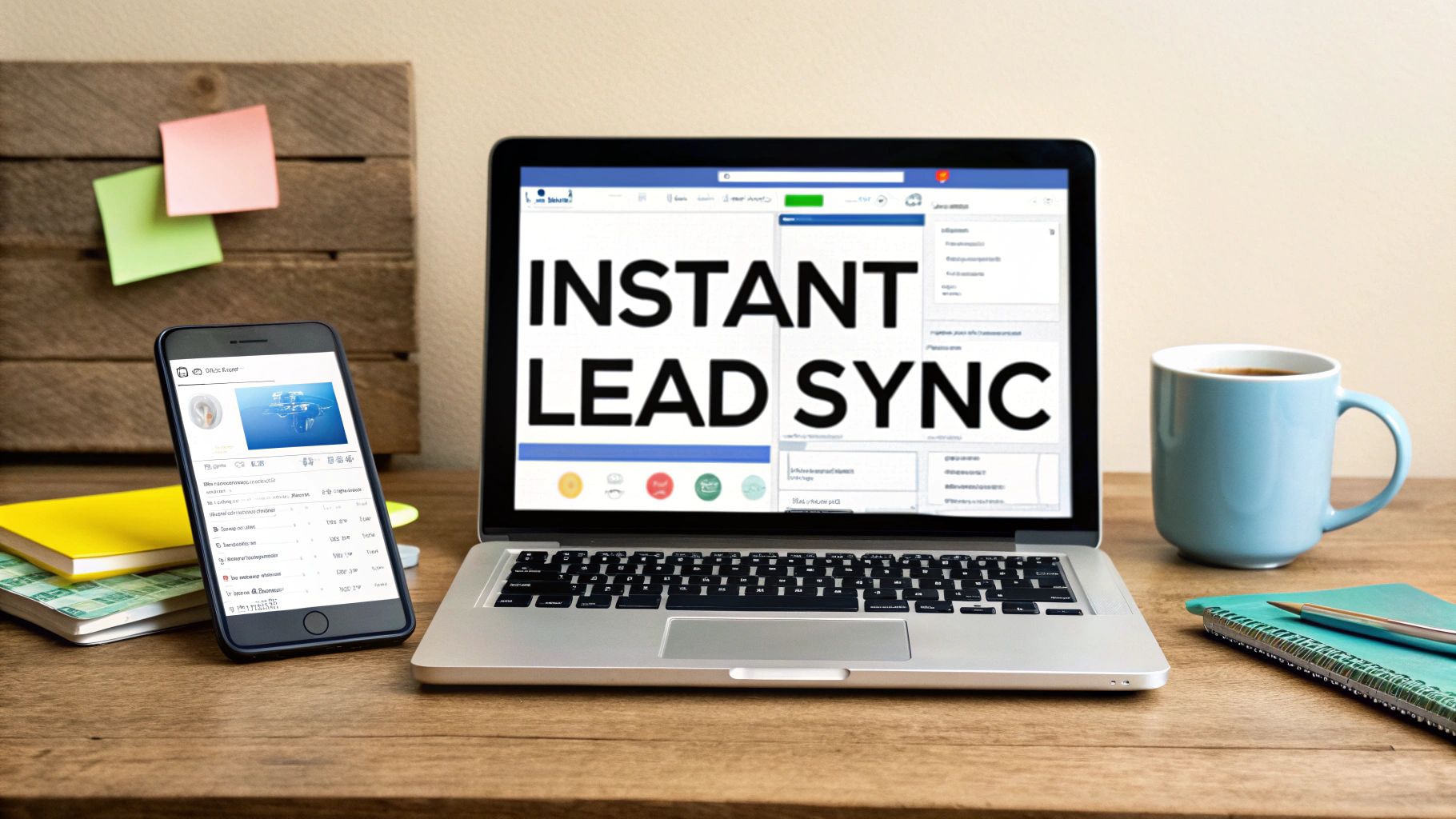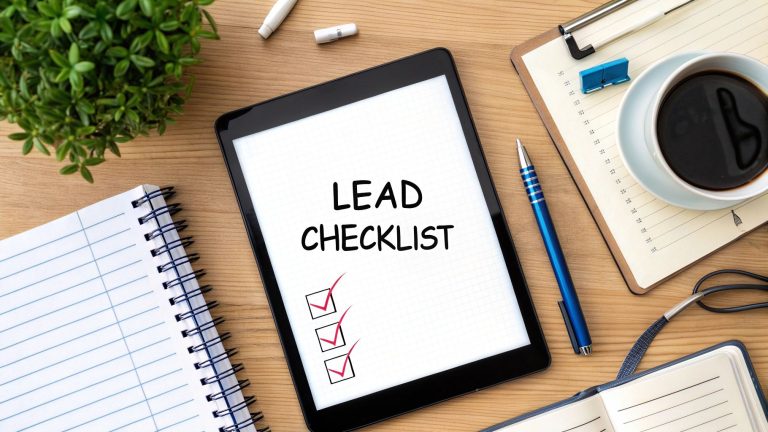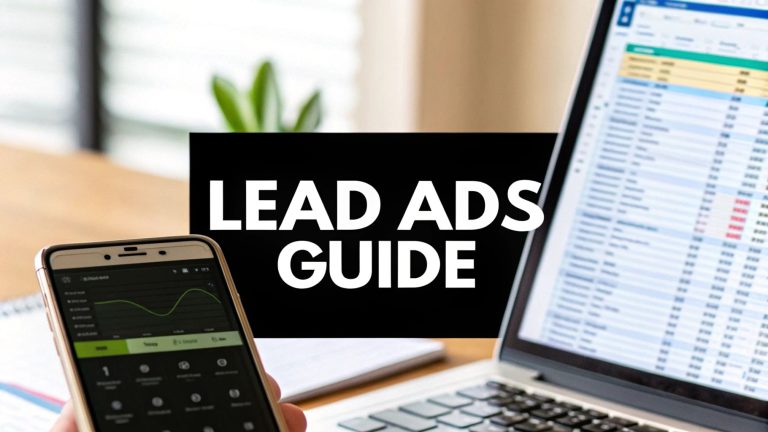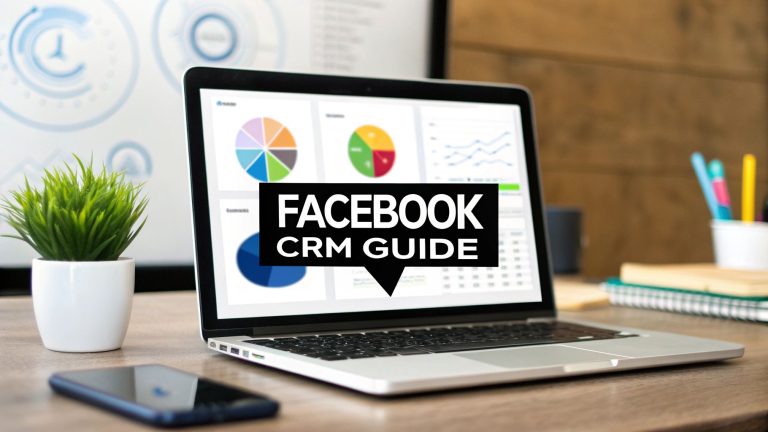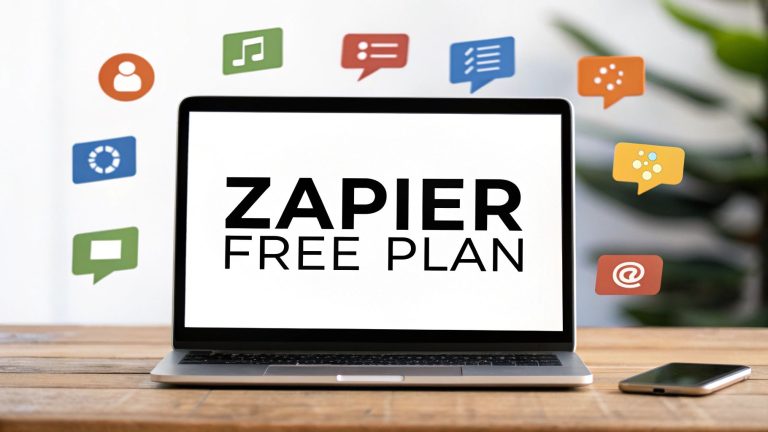Facebook Lead Ads Integration: Real Solutions That Work
Why Facebook Lead Ads Integration Changes Everything
Let's be real, manually downloading CSV files and copying lead data is a total time suck. I've seen businesses lose hot leads simply because their follow-up took too long. When you integrate your Facebook Lead Ads with your other systems, like your CRM, you're not just saving time, you're changing how fast you connect with potential customers. The agencies I work with who've nailed Facebook Lead Ads integration see leads flowing directly into their CRM in minutes, triggering instant, personalized follow-ups. We're talking about businesses going from 30% lead response rates to 85% just by removing that manual bottleneck.
This infographic shows some average performance metrics you can expect from Facebook Lead Ads: click-through rate (0.83%), cost per lead ($1.72), and conversion rate (12%). These benchmarks give you a good starting point for optimizing your campaigns.
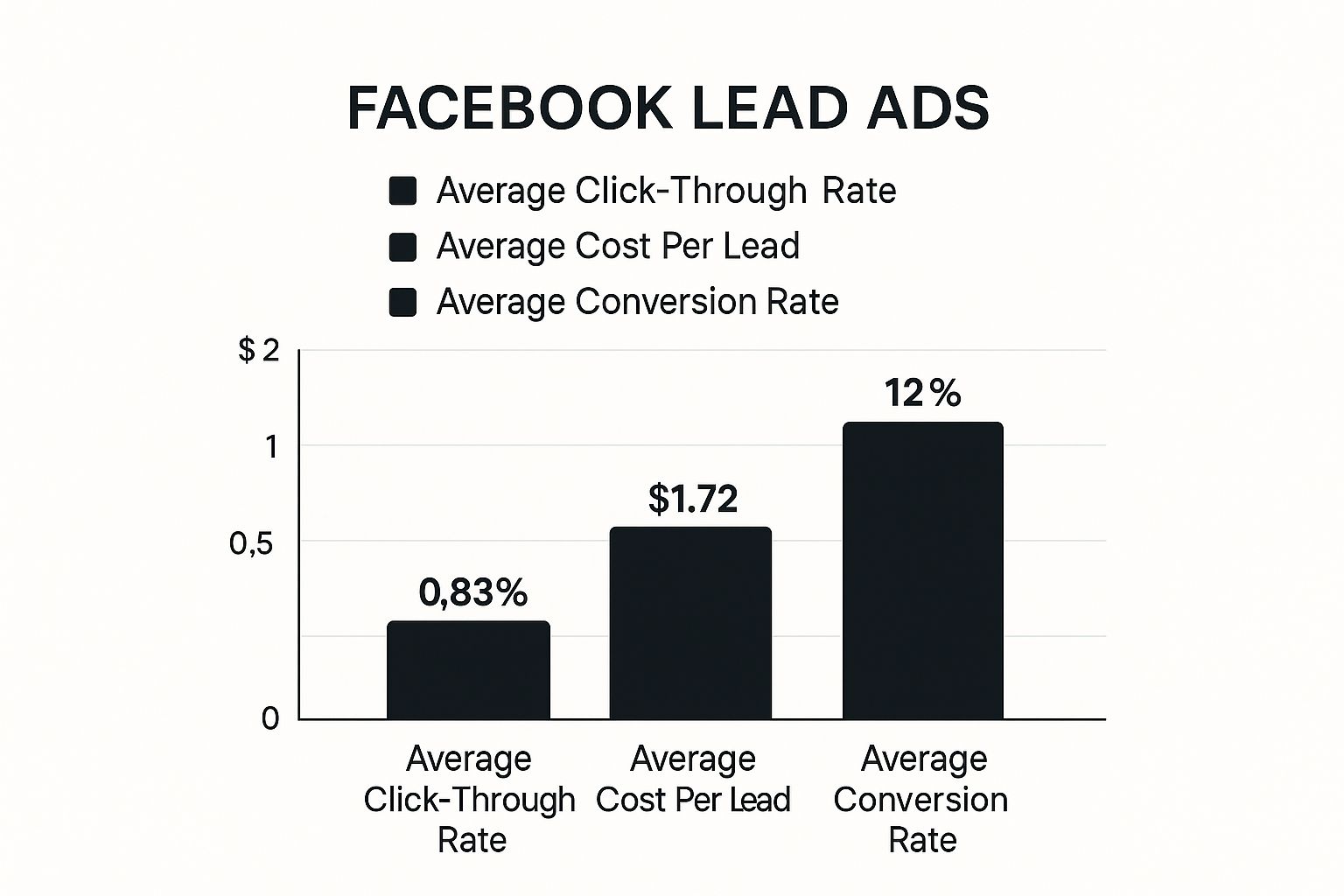
These averages are helpful, but keep in mind that your targeting and ad creative can seriously impact these numbers. A well-built campaign can crush these benchmarks and deliver even more value from your Facebook Lead Ads integration. Plus, Facebook's massive reach is a key player in lead generation. As of January 2025, Facebook ads could reach a whopping 2.28 billion users, making it second only to YouTube in ad reach among social media platforms outside of China. This wide reach lets businesses target diverse demographics, making Facebook a crucial tool for maxing out lead generation. Learn more about Facebook ad reach and demographics here.
Real-World Impact of Integration
Let me give you some real-world examples of how automated lead routing isn't just convenient—it's essential for staying competitive. A fitness studio I worked with tripled their consultation bookings by integrating their Facebook Lead Ads directly with their scheduling software. Leads could book a consultation instantly, right when they were most interested.
Another example? A B2B agency cut their sales cycle in half by routing high-value leads directly to their top sales reps with automated notifications.
That critical time between someone showing interest and getting a response? That's where potential revenue often disappears. Good integration closes that gap. By streamlining the process and ensuring quick follow-ups, businesses drastically improve their chances of converting leads into paying customers.
Let's talk about what this looks like in practice. The table below illustrates the stark difference between manual and automated lead management.
Manual vs Automated Lead Management Comparison
Side-by-side comparison of manual lead handling versus automated integration, showing time savings, response rates, and conversion improvements
| Process | Manual Method | Automated Integration | Time Saved |
|---|---|---|---|
| Lead Capture | Downloading CSV files | Direct import to CRM/Sheets | Hours per week |
| Lead Response Time | 1-2 days (or longer!) | Minutes | Hours/Days |
| Lead Qualification | Manual review | Automated tagging & scoring | Hours per week |
| Follow-up | Individual emails/calls | Automated sequences | Hours per week |
| Conversion Rate | Potentially 30% or less | Potentially 85% or more | N/A |
As you can see, automation isn't just about convenience; it's about significantly impacting your bottom line by dramatically shortening response times and increasing your conversion potential. In the next section, we’ll dive into setting up the right foundation for your Facebook integration.
Getting Your Facebook Foundation Right
Before we dive into the cool stuff – integrating your Facebook Lead Ads – let's talk about building a solid foundation. I've seen so many people skip this part, only to have their automations break down later. Setting up Facebook Business Manager isn't just about access; it's about structuring things for smooth integration with other tools.
Organizing Your Business Assets
Think of Business Manager as your Facebook marketing command center. You want it organized, especially if you're juggling multiple ad accounts or pages. This means grouping similar assets and using a clear naming system. For example, if you have campaigns for different products, create separate ad accounts for each. It keeps things tidy and makes reporting a breeze.
User Roles and Permissions
Ad account permissions are key. You need the right people to have access without risking security breaches. Don't just give everyone admin access! Assign roles based on what people actually do. A marketing manager might need full campaign access, while a client might only need to see reports. This prevents accidental changes and keeps things secure.
Critical Facebook App Permissions
Here's the tricky part that most tutorials miss: Facebook App permissions. Different integrations need different levels of access. Mess this up, and you'll have to rebuild everything later when you need those advanced features. I've been there, and it's not fun. Trust me, get it right the first time.

The Long-Term Benefits
This initial setup might feel like a chore, but it's the difference between a smooth-running integration and one that constantly needs fixing. Doing this groundwork now saves you headaches and makes sure your Facebook Lead Ads integration stays efficient and can grow with your business. It's an investment in the future of your lead generation. Now that we've got the Facebook basics down, let's move on to integrating your leads with Google Sheets.
Connecting Facebook Lead Ads to Google Sheets
Google Sheets is often the first stop for businesses diving into Facebook Lead Ads integration. It's free, flexible, and you don't need to be a coding whiz to use it. But there's a huge difference between a fragile setup that constantly breaks and a robust system that hums along for months. The key? Realizing that not all integration tools are created equal. I've experimented with a bunch, and tools like LeadSavvy Pro and Zapier each have their own strengths. It really depends on what you're trying to accomplish. Check out our guide on connecting Facebook leads to Google Sheets for more details.
Structuring Your Spreadsheet for Success
Don't just dump data into your spreadsheet and let it become a digital wasteland. Think about how you can structure it to actually help your sales process. That means setting up columns that make sense for your workflow. Things like lead source, contact info, what products they're interested in, and even a lead score. You can even use formulas to automatically calculate lead scores based on their answers and set up notifications to alert the right people without spamming everyone. It's like organizing your toolbox – you want to be able to quickly grab the right tool when you need it.
For example, let's say you run a fitness studio. You might have columns for "Fitness Goal," "Class Preference," and "Lead Score." Someone interested in weight loss and evening classes would get a higher score than someone who just downloaded a general fitness guide. Makes sense, right?
Advanced Google Sheets Tricks
Ready to take your Facebook Lead Ads integration to the next level? Automatic duplicate detection is essential. Trust me, Facebook sometimes sends the same lead twice. This feature will save you the embarrassment of contacting the same person multiple times. Setting up backup systems is also crucial. This will ensure you're capturing leads even if your main integration hits a snag. And don’t forget about organizing your data to spot trends and optimize your ad targeting. This is where you start getting real insights into what’s working and what’s not.
Speaking of what works, Facebook Lead Ads are undeniably effective, boasting average conversion rates around 9.21% across all industries. This high conversion rate is often attributed to lead conversion ads, which are particularly successful in sectors like fitness, education, and healthcare. These industries often see better results because their services naturally lend themselves to specific actions, like signing up for a course or booking a consultation. Discover more insights on Facebook ad statistics. Integrating these ads into your strategy can seriously boost your lead generation and conversion, making them an essential tool for any business looking to improve their online marketing.
Finally, a well-structured spreadsheet lets you see the big picture. You might notice that leads from a particular ad campaign have higher conversion rates, or that people who download a specific lead magnet are more likely to become customers. These insights are pure gold when it comes to refining your Facebook ad strategy and boosting your overall ROI. These aren't just theoretical tips – they're solutions to real problems that crop up as your lead volume grows. Now that we've covered Google Sheets, let's move on to integrating with a CRM.
CRM Integration That Actually Boosts Sales
Moving from spreadsheets to a proper CRM integration is where your Facebook Lead Ads strategy gets serious about driving revenue. I've seen firsthand how this can be a game-changer for businesses. When done right, the impact on sales performance is significant. The trick is understanding that each CRM has its own personality and optimal setup. Whether you’re working with HubSpot, Salesforce, Pipedrive, or GoHighLevel, knowing the nuances is key.
Mapping Your Fields for a Powerful Sales Process
Field mapping is more than just connecting Facebook's "email" field to your CRM's "email" field. It’s about strategically structuring your data to empower your entire sales process. Think of it like building a house: a solid foundation is essential. Beyond the basics, you might want to capture information about the product a lead is interested in, their budget, or even their company size. These details become invaluable for segmenting your leads and tailoring your follow-up.
Lead Scoring and Automated Follow-Up
This is where things get exciting: lead scoring. Imagine a system that automatically assigns points based on a lead's actions. A lead who downloads a high-value resource receives more points than someone who simply subscribes to a newsletter. This allows your team to prioritize their efforts and focus on the hottest prospects. You might find this helpful: CRM Integration with Facebook.
Then there’s the power of automated follow-up. When done well, these sequences feel personal, not robotic. Imagine a high-intent lead instantly receiving a calendar booking link, while a lead needing nurturing enters a different workflow. Tools like LeadSavvy Pro excel at this, enabling you to set up these complex automations with ease. It’s like having a tireless sales assistant working 24/7.
Routing Rules for Maximum Impact
Wouldn’t it be great if your top salespeople automatically received the highest-value leads? That’s exactly what routing rules accomplish. You can configure your CRM to assign leads based on their score, location, or any other criteria you define. This ensures your best performers are focused on the leads most likely to convert into customers.
The effectiveness of Facebook Lead Ads is evident in their click-through rate (CTR). Across industries, the average CTR hovers around 2.53%. While this may seem modest compared to other channels, the massive reach and high conversion potential of Facebook ads make them a powerful lead generation tool. Interestingly, mobile ad placements often outperform desktop placements by as much as 45%, highlighting the importance of mobile optimization. Discover more insights on Facebook ad statistics.
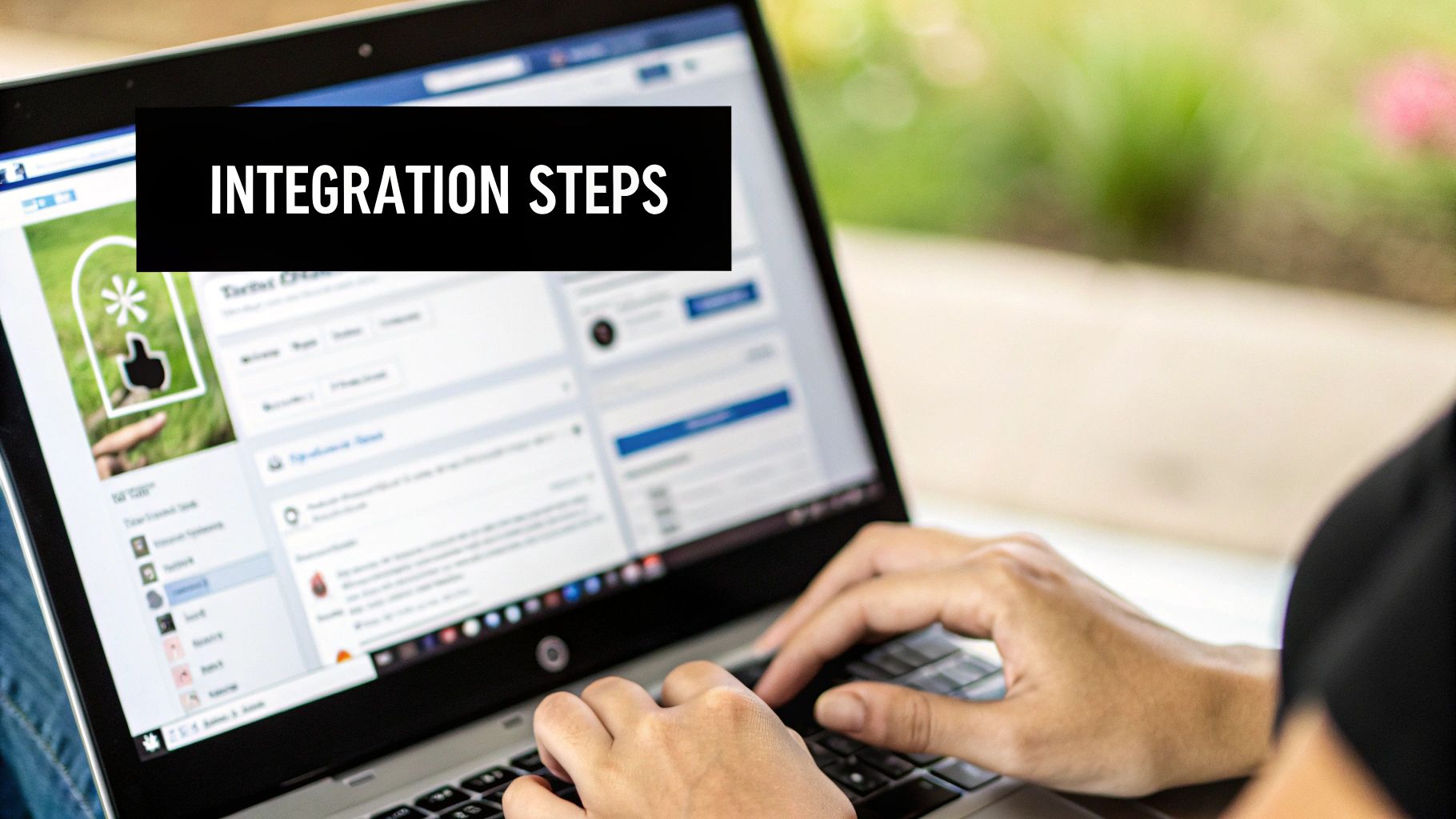
Conditional Logic: The Real Magic
The true power of CRM integration lies in conditional logic. This allows you to create “if-this-then-that” rules based on lead behavior. For example, if a lead downloads a specific guide, they're automatically tagged as interested in a particular product and entered into a targeted email sequence. This level of personalization is what truly elevates Facebook Lead Ads integration.
To help you choose the right CRM for your needs, I've put together a comparison of some popular options.
To help you navigate the CRM landscape, I’ve put together a comparison table showcasing key features and pricing across different platforms. This should give you a solid starting point for your research.
Popular CRM Integration Features Comparison
Detailed comparison of integration capabilities across major CRM platforms, including setup complexity, automation features, and pricing.
| CRM Platform | Setup Difficulty | Automation Features | Monthly Cost | Best For |
|---|---|---|---|---|
| HubSpot | Easy | Email marketing, lead scoring, workflows | $450+ | Small to medium businesses |
| Salesforce | Moderate | Sales automation, lead management, reporting | $25+ | Medium to large businesses |
| Pipedrive | Easy | Sales pipeline management, email integration, reporting | $14.90+ | Small to medium businesses, sales teams |
| GoHighLevel | Moderate | Marketing automation, CRM, reputation management | $97+ | Marketing agencies, businesses seeking all-in-one solution |
As you can see, the right CRM for you will depend on your specific needs and budget. Consider factors like the size of your business, your sales process complexity, and the level of automation you require.
In the following sections, we'll explore specific configurations for different business models and dive into troubleshooting tips to ensure your system runs smoothly.
Advanced Automation That Feels Personal
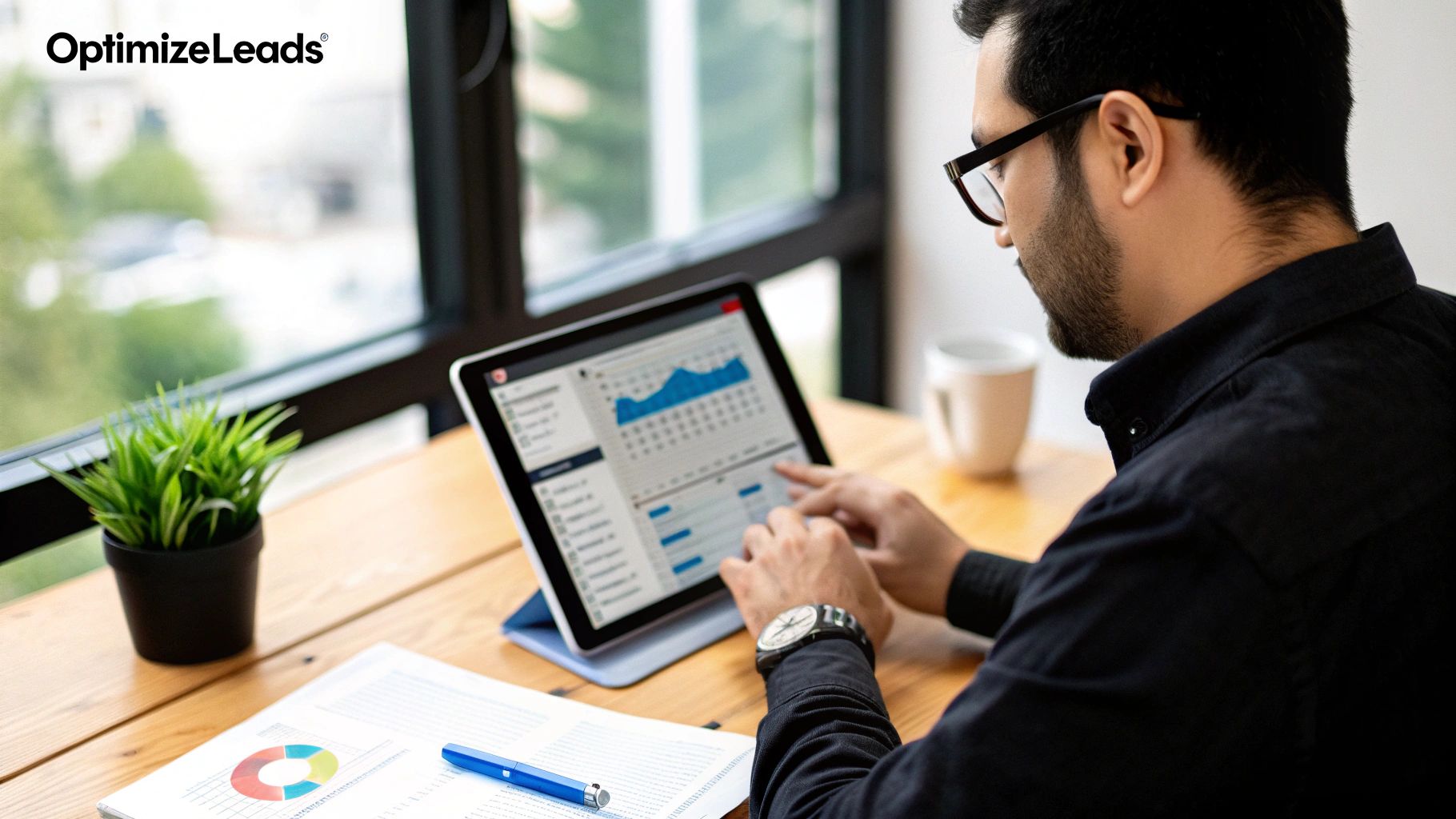
Once your Facebook Lead Ads integration is flowing smoothly, it's time to kick things up a notch and add some serious automation power. This is where the real magic happens, the point where you start seeing impressive improvements in your conversion rates. The trick is to create systems that feel intelligent and responsive, not like some clunky robot. I’m talking about using conditional logic to route leads based on their answers, their location, or even the time of day they submitted their information.
Think about it: a high-value lead from your ideal customer profile instantly gets routed to your top salesperson, along with a personalized text message. At the same time, someone who’s just casually browsing gets added to a nurture sequence perfectly matched to their interests. That’s the kind of personalized experience you can achieve with intelligent automation. You might find this helpful: How to automate lead generation.
Scoring Leads for Smart Prioritization
Setting up lead scoring based on various data points is a complete game-changer. For instance, someone who downloads a high-value lead magnet and watches your product demo video gets a higher score than someone who simply signs up for a newsletter. This helps your sales team focus their energy where it matters most – on the hottest leads. It's like a triage system in a hospital; the most critical patients get seen first.
This isn't just about efficiency; it's about making every interaction count. By prioritizing leads based on their engagement, you can personalize your outreach and significantly increase your chances of converting them into paying customers.
Dynamic Follow-Up Sequences
Forget those generic email blasts that end up in the spam folder. Dynamic follow-up sequences adapt and change based on how your prospects behave. If a lead clicks a link about a specific product, the next email they get should provide more details about that product. It's like having a real conversation, not just shouting into the void and hoping someone hears you.
I recently worked with a consulting firm that saw a 340% increase in their qualified lead rate after implementing behavioral triggers in their follow-up. They pinpointed key actions—downloading case studies or checking out pricing pages—that signaled high intent, then tailored their follow-up accordingly.
Building Backup Systems for Reliability
Let's be realistic: no system is foolproof. That's why having backup systems is essential. You need to ensure no leads slip through the cracks, even if there's a hiccup with your primary integration. This could be something as simple as a manual process or a secondary integration tool.
I helped a SaaS company cut their sales cycle in half by implementing intelligent lead routing. They integrated their Facebook Lead Ads directly with their CRM and routed leads based on specific criteria. This meant the right sales reps connected with the right leads immediately.
These advanced Facebook Lead Ads integration strategies aren't just theoretical concepts. They're practical, real-world solutions that can significantly boost your lead conversion rates and overall business performance. These are battle-tested methods adaptable to any business model.
Fixing What Breaks Before It Breaks You
Let's be honest, every Facebook Lead Ads integration will eventually have a hiccup. It usually happens at the worst possible time, too. Picture this: you're running your biggest campaign of the year, leads are flowing in, and bam! The integration decides to take a vacation. I've pulled my share of all-nighters wrestling with these systems, and trust me, there are definitely recurring themes in the mayhem.
Common Integration Failures
So, what typically goes wrong? Usually, it's a Facebook API change that throws a wrench in your data flow. Duplicate leads can clog your CRM like a digital artery. Formatting issues can bring automated workflows crashing down. And then there are rate limits, which can bring everything to a screeching halt. I once had a client whose perfectly functioning integration imploded because Facebook changed a single field name in their API. Tracking that down took hours.
That experience drilled home a crucial lesson: proactive monitoring is everything when it comes to smooth Facebook Lead Ads integration. Spotting potential problems before they become full-blown disasters will save your sanity (and your sleep).
Building a Monitoring System
How do you build a monitoring system that actually works? First, set up alerts that are helpful, not the kind that spam your inbox every five minutes. You want alerts that flag genuine issues. Think unusual lead volumes, inconsistencies in data formatting, or delays in synchronization. These small changes can be early warning signs of bigger problems.
Don't forget manual backup processes. Automation is fantastic, until it isn't. When things go sideways, having a manual system—even a temporary Google Sheets setup—can be a lifesaver. It's your safety net.
Finally, build a relationship with the support teams at your integration platforms. Seriously, this is huge. Knowing who to contact and having that connection already in place can drastically reduce resolution times when problems inevitably arise.
Recovery Strategies When Things Go Wrong
Even with the best monitoring, things will still break. The key question is: how quickly can you recover? This is where documented recovery strategies are crucial. You need to know exactly what to do to restore your Facebook Lead Ads integration. For example, have a documented process for restarting your integration tool, refreshing your API connections, or manually importing leads collected during the outage.
This isn't just about putting out fires; it's about minimizing the impact on your business. Having emergency workflows at the ready—like a temporary landing page or a manual email capture system—can keep your lead flow going while you fix the main issue. These are the techniques that separate businesses that lose valuable leads during outages from those that weather the storm. In the next section, we’ll dive into how to measure the true effectiveness of your Facebook Lead Ads integration and optimize for real growth.
Measuring What Matters for Real Growth
The real test of your Facebook Lead Ads integration isn't just that it works—it's that it makes your business more profitable. I've seen countless people get obsessed with high lead volumes, completely forgetting the metrics that truly move the needle: conversion rates, customer lifetime value (CLTV), and revenue attribution. Vanity metrics might look impressive on a report, but they won't keep the lights on.
Tracking Leads from Click to Close
You absolutely need a system that tracks leads from their initial click all the way to a closed sale. This means connecting your Facebook ad spend to actual business outcomes. Picture this: a prospect clicks your ad, fills out a lead form, gets added to your CRM, receives a series of automated emails, and finally makes a purchase. Can you trace that entire journey? If not, you're missing incredibly valuable data that could be used to optimize every single step.
I've personally witnessed businesses double their conversion rates just by identifying and fixing bottlenecks in their lead flow. For example, I worked with a software company that discovered a confusing checkout process was costing them a fortune. A simple checkout redesign led to a dramatic increase in sales.
System Audits and A/B Testing
Regular system audits are crucial. Think of them as a health check for your Facebook lead ads integration. They can help you catch small inefficiencies before they snowball into major problems. It's like checking the oil in your car—a small fix now prevents a major breakdown later. You might discover, for instance, that leads aren't being tagged correctly in your CRM, which slows down follow-up. Or maybe your automated email sequence just isn't resonating with prospects. These audits shine a light on the weak points that are quietly draining your budget.
A/B testing different integration approaches is also essential. This means comparing two versions of your system to see which one performs better. Perhaps you test two different lead capture forms, or two different CRM workflows. By systematically testing and measuring, you can constantly refine your integration for maximum ROI. I once worked with an e-commerce store that saw a 15% conversion increase simply by adding a personalized video to their welcome email. A small tweak, discovered through A/B testing, with a massive impact on their bottom line.
Performance Benchmarks and Data-Driven Decisions
Understanding if your system is truly optimized, or just "functional," requires performance benchmarks. These benchmarks give you a target to strive for and a way to measure your progress. You might, for example, set a benchmark for your lead response time, aiming to contact new leads within five minutes. Or you could set a conversion rate target of 20%. These benchmarks keep your team focused on the important stuff and drive continuous improvement.
Successful businesses use integration data to make smart decisions about where to invest their marketing dollars. This could mean adjusting your Facebook targeting, refining your sales process, or even developing new products based on customer feedback. It’s all about using data to understand what your customers want and how to best serve them.
Stop tracking everything and start tracking the right things. Use that data to continuously improve your Facebook lead ads integration and watch your business grow.
Ready to simplify your Facebook Lead Ads integration and unlock real growth? Discover the power of LeadSavvy Pro today.

